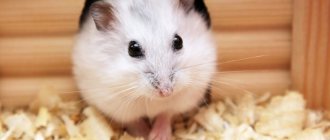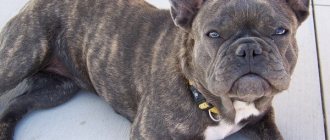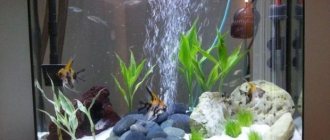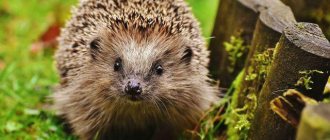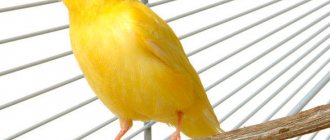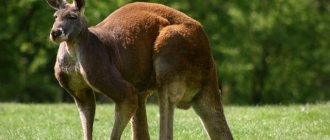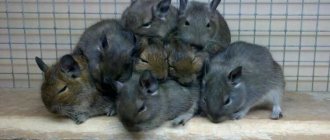- home
- General information
11/01/2018 A small steppe animal can bring no less positive emotions than a cat or dog. Unfortunately, the lifespan of a hamster is not that long. However, there are nuances of maintenance and care that can significantly increase the life expectancy of a pet.
What determines the lifespan of a Djungarian hamster?
Any external factors greatly affect the condition of a small animal, so the issue of maintenance must be taken seriously.
Care
- Provide your pet with a decent home, while taking into account the unshakable hamster rule: “ Each hamster has a separate cage . These harmless animals are actually very sensitive to the issue of their territory, and any “stranger” in their cage can lead to aggression and even a fight.
- Clean the rodent's cage in a timely manner, avoid the accumulation of garbage and excrement, the smell of which can quickly spread throughout the house.
- To prevent your small rodent from getting hurt, do not buy cotton wool for it. The hamster runs the risk of getting entangled in it, and the cotton wool can wrap around any part of the tiny body. Instead, it is better to bring napkins to the hamster's cage - this is the best option for building nests.
Give your pet the attention it needs just as much as cats and dogs.
- Protect your hamsters' ears from any noise, be it the radio, TV or loud conversations . This can create a stressful situation for your pet.
- Also exclude any bright light, which these nocturnal animals do not like. Most of all, they cannot tolerate daylight; it is also harmful for them to be in direct rays.
What should jungarika eat?
Nutrition
Healthy food is another success on the path to longevity for your pet. To do this, add the following to your animal’s diet:
- Ready-made nutritional formulations. Such kits are sold in pet stores; they represent proper balanced nutrition , which is selected specifically for hamsters. They often contain corn, wheat, peas and nuts - everything that rodents love so much.
- Fresh fruits and vegetables. Focus on zucchini and carrots, and it is better to exclude cabbage and onions, as they can harm the health of jungarians. All citrus fruits should be excluded from fruits, and apricots, bananas and apples are the most optimal for hamsters.
Protein is another substance that keeps your pet healthy. In order for the dwarf to get protein, give him meat several times a week.
- Special vitamins. It is better to discuss recommendations for their purchase directly with a specialist.
- Regularly replenish your rodent's water bowl with water. IMPORTANT: Water must be distilled.
Genes
Like humans, hamsters may have a genetic predisposition to diseases . Thus, genes sometimes result in the development of certain diseases. Therefore, when purchasing, it is better to get a hamster that had healthy parents.
Also, genetics can have a hamster's life expectancy for the better. If a rodent has long-livers in its family, then it will probably live a long time. Such a gene can also have a positive effect on the animal’s immunity.
This means that it will be more resistant to disease. The right decision would be to contact professional hamster breeders, so you can find out more about the parents of the future pet. Did you find out about your pet's pedigree before purchasing? What do Djungarians often get sick with?
Diseases
Since you are dealing with a helpless animal, you need to monitor its health very carefully. Especially if you want to ensure a long and happy life, then monitor illnesses in advance using symptoms such as:
- Decreased activity.
- Constant fatigue and lethargy.
- Drowsiness.
- Labored breathing.
- Deterioration of fur.
If one of the symptoms appears, you should immediately consult a doctor . The earlier you detect the disease, the easier it will be to get rid of it.
- The Dzungarian may catch a cold, which is usually indicated by sneezing and sniffling. In this state, the animal needs your care and attention, while feeding your pet fresh fruit - this way he will recover faster. IMPORTANT: Use any medications or injections only with a doctor’s prescription.
A problem with teeth may be indicated by the fact that the hamster is not eating well. The cause may be damage to the oral cavity or overly long incisors. Probably, because of the pain, it is simply difficult for the pet to chew food. In this situation, only a doctor can help; in some cases, the procedure to shorten the length of teeth is carried out at home.
- Djungarians may also experience intestinal and stomach diseases . This can be determined by loose stools, an unpleasant odor, or rumbling in the animal’s tummy.
- The animal may also develop a tumor disease, but you should not make hasty decisions if you just find a lump or lump. In this case, you need to consult a doctor for an accurate answer.
- Protect your pet from fractures , because a serious injury can leave your pet lame for the rest of its life. In case of watering, bruising or other damage, immediately take the hamster to the veterinarian, only he will give you the correct recommendations for recovery.
How long can a hamster live without active movement?
Like any living creature that can jump and run, the dzhungarik cannot be healthy without an active lifestyle. To keep your animal in good shape, provide it with the necessary equipment: exercise equipment, walking balls or a wheel.
Remember that a hamster will not be able to live long with plenty of food and little activity , this can lead to intestinal diseases, which can have harmful consequences. To avoid this, constantly give him space to be active, be it his crate or the floor of your apartment.
At what age is it better to buy a hamster?
Additional recommendations
Tips from hamster owners:
- If you want to have 2 or more rodents, the spacious cage is divided with a piece of plexiglass.
- When breeding hamsters, immediately after mating, the male is placed separately. Males like to live alone, and males also eat newborns.
- They do not let the pet out of the cage: it moves so quickly that it is easy to lose sight of it. Having become entangled in clothes, the animal gnaws and spoils things in order to find a way out.
- They prevent the animal from falling, because he doesn't feel heights.
The Djungarian hamster is an unpretentious animal. Conscientious care prolongs your pet's life.
How to extend the life of a Djungarian hamster: basic rules
If your task is to significantly extend the life of your hamster, providing him with the maximum possible longevity, then take each of the above points seriously.
- Respect the natural environment of dwarfs, which do not tolerate bright light. To do this, place the cage away from the window so that the animal does not receive unnecessary stress from excess daylight.
- Take care of your pet's hygiene. Since the rodent spends most of its time in the cage, constantly clean it . At least once a week it is necessary to wash the entire house, periodically change the bedding there and remove excrement. This will ensure clean and fresh air around the cage space.
- “We are what we eat” is a phrase that also applies to Djungarians. Feed him exclusively healthy food, while relying on the animal’s natural preferences. Sometimes give him harmless treats in the form of a piece of banana or apple. This will significantly lift the animal’s mood and give a new boost of energy.
- The basis of nutrition should be grains and legumes , such as corn grains, peas, seeds, nuts, rice grains and wheat.
- As mentioned earlier, you can purchase ready-made nutritional mixtures at pet stores; these kits include all the useful components for your pet.
- Do not exclude meat from his diet, which is rich in protein and healthy fats.
All about dzhungarikas - video
If all of the above conditions are met, your pet can live a long and happy life. In addition to the basic rules of care, do not forget about love and care. These little creatures are constantly in need of someone's help, so always be ready to provide it.
How many years do Djungarian hamsters live: at home and in the wild?
Under natural conditions, the life expectancy of Djungarian hamsters rarely exceeds one and a half years. An animal that has reached 2 years of age has every right to be called a long-liver. Surviving in the wild comes with many dangers. Every day, crawling out of its burrow in search of food, the hamster risks:
- become a victim of predators;
- get injured or sick;
- can't find a source of food.
Living in the wild for the Djungarian means constantly being prepared for danger, and, accordingly, always being in a state of tension and stress. This factor also does not contribute to increasing life expectancy.
In addition, even being in a hole and having a supply of food, the hamster continues to feel defenseless, and in winter it may suffer from the cold.
At home, everything is different - the furry animal is not in danger of frost, hunger, or other animals. In a cozy house (cage), the hamster feels protected, which minimizes his stress and anxiety. Therefore, the life expectancy of a dwarf at home will also be different; a hamster can easily live up to 2 years. If the owner regularly communicates with the pet and properly cares for it, the dzhungarik lives for 3 or (which happens less often) 4 years.
Reproduction
To mate and successfully reproduce Djungarian hamsters, you will need a female about four months old and a three-month-old male. For breeding purposes, they need to be transplanted into a separate container for a while, protected from their relatives.
Pregnancy among Djungarians takes about 20 days. After the specified time, from 4 to 12 cubs can be born. Hamsters are born blind and helpless. Over the next month, they are under the care of their mother, regularly drinking milk.
There are a number of other important points when breeding Djungarian hamsters. So, shortly before giving birth, it is necessary to place the female in a pre-cleaned, disinfected cage. And after the babies are born, you should not pick them up or touch them. Having smelled foreign odors from the cubs, the female may reject the offspring. In such situations, cases of cannibalism are often observed.
Description
Author: Kristina Forlovskaya
Djungarian hamsters are small animals of the hamster family, the genus Hairy-footed. The body is covered with short, light gray fur. A darker stripe runs along the back; this is how Djungarian hamsters are usually recognized.
The paws are also covered with hair, but white. In clean pets they are a pleasant white-pink color. The ears are small and round. The beady eyes are slightly protruding. The body is small. The body length of an adult dwarf is 10 cm.
Sexual characteristics
It is quite difficult to examine sexual characteristics in a pet store if you have no experience communicating with such small animals. The seller can help. He can hold the animal so that it is comfortable to watch.
If the hamster is a boy, there is a gap of 0.5 cm between the genitals and the anus and there is a formation on the tummy that resembles a navel. If it is a girl, then the gap is almost invisible, and two stripes of papillae run along the tummy.
Cage care
Caring for the cage will not take much time. The tray must be filled with sawdust. Pet stores sell compressed sawdust. One pack lasts a long time. The sawdust will need to be renewed periodically.
You don't need to wash the cage very often. The animals are small and the bars of the cage remain clean for a long time. You need to remove and wash the wheel, house, drinking bowl, stairs, tunnels. You will have to vacuum the floor around the cage frequently. Djungarians actively stir up sawdust, building nests, and scatter food if there are family squabbles or they don’t like the food.
